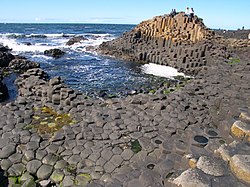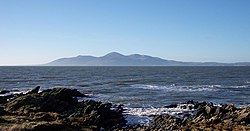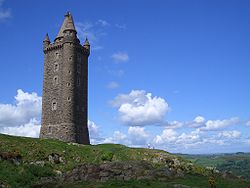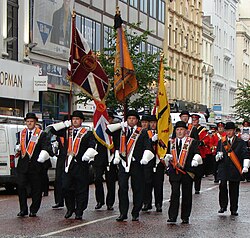Northern Ireland

Northern Ireland is that part of the United Kingdom on the island of Ireland, consisting of six counties, namely the counties of:
Northern Ireland takes up the northern part of the island with the exception of County Donegal, a county of the Republic of Ireland standing to the west, between Northern Ireland and the Atlantic Ocean. It is a place of variety, from its major city, Belfast and the heavily inhabited lands around it, out to almost empty countryside, from the low-lying lands of the River Bann and Lough Neagh in the heart of the land, to dramatic mountain scenery and noble, ocean-girt sea cliffs.
Since 1998, Northern Ireland has had a devolved administration, seated outside Belfast, albeit that it has been suspended on occasion since then.
Northern Ireland was for many years the site of a violent and bitter inter-communal conflict known as "the Troubles" fought out between nationalists who sought to unite Northern Ireland with the Republic of Ireland, and unionists who sought to preserve its position as part of the U.K. This division reflects the division of the population between Protestants, who are overwhelmingly unionist with a strong British identity, and Roman Catholics, who carry an Irish identity and tend to nationalism. Since 1998, most of the paramilitary groups involved in the Troubles have ceased their campaigns of violence.
Before the Troubles began, these counties were the most enterprising and most industrialised region of the island. The Troubles smashed this prosperity. Since the peace in the 1990s prosperity and enterprise are slowly returning.
Geography and climate


Northern Ireland was covered by an ice sheet for most of the last ice age and on numerous previous occasions, the legacy of which can be seen in the extensive coverage of drumlins in the counties of Fermanagh, Armagh, Antrim and particularly Down. The centrepiece of Northern Ireland's geography is Lough Neagh, at 151 square miles the largest freshwater lake in the British Isles.
A second extensive lake system is centred on Lower and Upper Lough Erne in Fermanagh. The largest island of Northern Ireland is Rathlin, off the north Antrim coast. Strangford Lough is the largest inlet in the British Isles, covering 58 square miles.
There are very few off-shore islands; the only inhabited island is Rathin Island off the north coast of County Antrim. A little to the north though stretch the Inner Hebrides, more than adequate compensation. The peoples of the Hebrides and of Ulster have had close contact over countless centuries, their histories intertwining.
The highest mountains are the Mourne Mountains in County Down; grand, granite hills dropping dramatically to the sea. There are substantial uplands too in the Sperrin Mountains (an extension of the Caledonian fold mountains) with extensive gold deposits. A ridge of hills in the north of County Antrim is cut through withthe famed Glens of Antrim. Smaller ranges of hills rise in South Armagh and along the Fermanagh–Tyrone border. None of the ranges of hills is especially high, but Slieve Donard in the Mourne Mountains reaches 2,785 feet, Northern Ireland's highest point. Belfast's most prominent peak is Cavehill.
The volcanic activity which created the Antrim Plateau also formed the eerily geometric pillars of the Giant's Causeway on the north Antrim coast. Also in north Antrim are the Carrick-a-Rede Rope Bridge, Mussenden Temple and the Glens of Antrim.
The Lower and Upper River Bann, River Foyle and River Blackwater form extensive fertile lowlands, with excellent arable land also found in North and East Down, although much of the hill country is marginal and suitable largely for animal husbandry.
The valley of the River Lagan is dominated by Belfast, whose metropolitan area includes over a third of the population of Northern Ireland, with heavy urbanisation and industrialisation along the Lagan Valley and both shores of Belfast Lough.
Economy

Northern Ireland has traditionally had an industrial economy, most notably in shipbuilding, rope manufacture and textiles, but most heavy industry has since been replaced by services, primarily the public sector.
Tourism also plays a big role in the local economy. More recently the economy has benefited from major investment by many large multi-national corporations into high tech industry. These large organisations are attracted by government subsidies and the skilled workforce available.
The economy suffered for many years during The Troubles; enterprise was threatened by terrorists and by extortion and government money poured in to soothe opinion wiped out private enterprise and the habit of enterprise for which the counties of Ulster were once renowned. Fair enmployment laws had a crippling effect too. Many of the most enterprising left Ulster for Great Britain. Thus in the latter half of the twentieth century Northern Ireland gained a huge tax-funded sector and lost its enterprise. Only in recent years has this begun to change.
History

The lands which became Northern Ireland gained their character with the Plantations begun by King James I; a huge transplantation of population was effected such as to transform these counties of Ulster from the heartland of the Gaels and of the Roman church into a British, Protestant land. The Plantation splits the history of Ulster in two.
Plantation
The region that is now Northern Ireland was the centre of resistance to English rule, which culminated in the "Nine Years War", a war of resistance against the Plantation. Ireland had been under the English Crown since Henry II, but effective control from Dublin was fragmentary; the Gaelic chiefs and Anglo-Norman landowners were the real power in the land. The Tudors began to wrest control from the chiefs, but in Ulster the Gaelic chiefs were particularly resistant, infamous names of this time include Hugh O'Neill Earl of Tyrone, descendant of ancient High Kings, and Sorley Boy, chief of the O'Donnells from the Hebrides. The chiefs were defeated at the Battle of Kinsale in 1607 and Ulster's Gaelic, Roman Catholic aristocracy fled to Europe in the "Flight of the Earls".
The Flight of the Earls permitted King James to begin a massive programme to colonise Ulster with Protestant English and Scottish settlers. Between 1610 and 1717 perhaps as many as 100,000 Lowlanders came across from Scotland, and by the latter date there were some five Scots to every three Irishmen and one Englishman in Ulster.[1]
It is said that here in Ulster the first united British identity arose, as Scots and English mixed in common cause.
A rebellion in 1641 by Irish chieftains and landowners against English rule resulted in a massacre of settlers in Ulster, taking advantage of the civil strife in Great Britain in the Covenanters War, and fuelled by resentment at government persecution of the Roman religion. The rebellion was put down and consolidated the Protestant settlement of Ulster. War came again after King James II was deposed in 1688 in favour of William of Orange. The iconic victories won by English forces and local Protestants at the Siege of Derry in 1689 and the Battle of the Boyne in 1690 are still celebrated with great fervour each year by the Protestant community.
Eighteenth century
After the victory of 1691, a series of penal laws was passed by the Parliament of Ireland (elected from the Anglican, Protestant Ascendancy) which materially disadvantaged the Roman Catholic community and, to a lesser extent, the Presbyterian community. In response the 18th century saw secret, militant societies develop in communities in the region and act on sectarian tensions in violent attacks. These events escalated at the end of the century following an event known as the Battle of the Diamond, which saw the supremacy of the Anglican and Presbyterian Peep o'Day Boys over the Roman Catholic Defenders and leading to the formation of the (Anglican) Orange Order.
Between 1717 and 1775 some 250,000 people from Ulster emigrated to the American colonies.[2] It is estimated that there are more than 27 million descendants of the Scots-Irish migration now living in the United States.[3]
A rebellion in 1798 led by the cross-community Belfast-based Society of the United Irishmen and inspired by the French Revolution sought to break the constitutional ties between Ireland and Britain and unite Irishmen of all communities.
After this rebellion, in an attempt to quell sectarianism and force the removal of discriminatory laws the government of Great Britain pushed for the two kingdoms to be united. The new state, formed in 1801, the United Kingdom of Great Britain and Ireland, was governed from a single government and parliament based in London.
The Partition of Ireland

During the 19th century, legal reforms started in the late 18th century removed statutory discrimination against Roman Catholics and progressive programmes enabled tenant farmers to buy land from landlords. By the close of the century, autonomy for Ireland within the United Kingdom, known as Home Rule, was regarded as highly likely, but was blocked by the House of Lords, causing much discontentment amongst Irish Roman Catholics. The Parliament Act 1911 enabled the Commons to overrule the Lords in cases of deadlock, and opponents of home rule saw that it would be imposed: the response from Ulster, where Protestant unionists were a majority, was dismay ("Home Rule means Rome Rule") and a threat of armed resistance: "Ulster will fight; Ulster will be right" said Randolph Churchill. In 1912, Ulstermen signed the "Ulster Covenant" pledging to resist the imposition of home rule in Ulster. In 1914, unionists smuggled thousands of rifles and rounds of ammunition from Imperial Germany and the Royal Navy managed to turn a blind eye to the shipment.
Home rule was enacted in 1914 by the Government of Ireland Act (the third attempt to push a Home Rule Bill through Parliament). The Act provided for the partition of Antrim, Armagh, Downshire, Fermanagh, Londonderry and Tyrone from the rest of Ireland, but the Great War broke out in September 1914 and the implementation of the Act was suspended before it came into effect. The war was not "over by Christmas" but dragged for four bloody years and by the time of the armistice events had left it impractical to implement, not least the brief, treacherous rebellion of the Easter Rising in 1916. Public opinion in the "nationalist" community had shifted during the war from a demand for home rule to one for full independence. The Government of Ireland Act 1920 divided Ireland into two home rule areas: Southern Ireland of twenty-six counties and Northern Ireland of six counties, but the former never became effective; only two members turned up at the new Parliament of Southern Ireland and Sinn Féin, having won 73 of Ireland's 105 parliamentary seats, unilaterally established a Dáil in Dublin, an unauthorised parliament. Northern Ireland however was firmly established.
A civil war broke out openly between Nationalist forces and British forces, which ended with the Anglo-Irish Treaty, taking effect on 6 December 1922. The Irish Free State was created and Northern Ireland was given a right to exclude itself from the state, which it did at once by an address to the King on 7 December 1922.
Northern Ireland
On 7 December 1922, the Parliament of Northern Ireland resolved to make an address to the King:
| “ | Most Gracious Sovereign, We, your Majesty's most dutiful and loyal subjects, the Senators and Commons of Northern Ireland in Parliament assembled, having learnt of the passing of the Irish Free State Constitution Act 1922, being the Act of Parliament for the ratification of the Articles of Agreement for a Treaty between Great Britain and Ireland, do, by this humble Address, pray your Majesty that the powers of the Parliament and Government of the Irish Free State shall no longer extend to Northern Ireland.[4] | ” |
A commission to decide on the territorial boundaries between the Irish Free State and Northern Ireland was delayed when civil war broke out in the Free State and the work was eventually abandoned, leaving Northern Ireland as it was.
The Troubles
The Troubles, starting in the late 1960s, consisted of about thirty years of recurring acts of intense violence between elements of Northern Ireland's nationalist community (principally Roman Catholic) and unionist community (principally Protestant) during which 3,254 people were killed.[5] The conflict was caused by the rival aspirations of the two communities, seeking to drag Northern Ireland into the Irish Republic or to preserve its loyalty to the Crown. The Irish Republican Army committed acts of violence from the very creation of Northern Ireland, but from 1969 it became a sustained terrorist campaign, drawing on Roman Catholic aspirations and resentment at certain aspects of life and government, such as the limiting of the franchise to rate-payers (overwhelmingly Protestant). From 1967 to 1972 the Northern Ireland Civil Rights Association protested perceived discrimination, and the IRA exploited this for their own ends.
The terrorist campaign of the Provisional IRA raged from 1969 to 1997, and the Ulster Volunteer Force (formed in 1966) struck in reaction, with the army and police, the Royal Ulster Constabulary, in the middle trying to maintain law and order while being targeted for murder by the IRA. The IRA exploded bombs in town centres and polices stations, mainly in Ulster but also in Great Britain. Protestant farmers in Fermanagh were picked off one by one. Both the IRA and UVF shot and punished opponents and those seen as collaborating. While most of Ulster lived in peace and the good nature which characterises the folk of Ulster, Belfast and certain other towns lived almost under siege at the worst times.
Home rule in Northern Ireland was suspended in 1972, and restored in a form only when the killing had stopped.
Culture

With its improved international reputation, the counties of Northern Ireland have witnessed rising numbers of tourists in the twenty-first century. Attractions include cultural festivals, musical and artistic traditions, countryside and geographical sites of interest, public houses, welcoming hospitality and sports (especially golf and fishing). Since 1987 public houses have been allowed to open on Sundays, despite some opposition.
The Ulster Cycle is a large body of prose and verse centring around the traditional heroes of the Ulaid in what is now eastern Ulster. This is one of the four major cycles of Irish Mythology. The cycle centres around the reign of Conchobar mac Nessa, who is said to have been king of Ulster around the time of Christ. He ruled from Emain Macha (now Navan Fort near Armagh), and had a fierce rivalry with queen Medb and king Ailill of Connacht and their ally, Fergus mac Róich, former king of Ulster. The foremost hero of the cycle is Conchobar's nephew Cúchulainn.
Outside links
- Discover Northern Ireland (Northern Ireland Tourist Board)
References
- ↑ James G. Leyburn (December 1970). "The Scotch-Irish". American Heritage Magazine 22 (1). Archived from the original on 3 December 2008. http://web.archive.org/web/20081203112227/http://www.americanheritage.com/articles/magazine/ah/1970/1/1970_1_28.shtml.
- ↑ Thernstrom, Stephan (1980). Harvard encyclopedia of American ethnic groups. Harvard University Press. p. 896. ISBN 0-674-37512-2.
- ↑ "Born Fighting: How the Scots-Irish Shaped America". Powells.com. 12 August 2009. http://www.powells.com/biblio/1-9780767916899-1. Retrieved 30 April 2010.
- ↑ Northern Ireland Parliamentary Report, 7 December 1922
- ↑ Malcolm Sutton’s book, “Bear in Mind These Dead: An Index of Deaths from the Conflict in Ireland 1969–1993.
Further reading
- Jonathan Bardon, A History of Ulster (Blackstaff Press, Belfast, 1992), ISBN 0-85640-476-4
- Brian E. Barton, The Government of Northern Ireland, 1920–1923 (Athol Books, 1980)
- Paul Bew, Peter Gibbon and Henry Patterson The State in Northern Ireland, 1921–72: Political Forces and Social Classes, Manchester (Manchester University Press, 1979)
- P. Hackney (ed.) Stewart's and Corry's Flora of the North-east of Ireland 3rd edn. (Institute of Irish Studies, Queen's University of Belfast, 1992), ISBN 0-85389-446-9(HB)